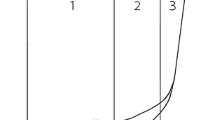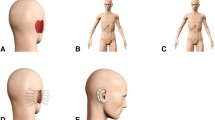Abstract
Background
The reconstruction of scalp alopecia is necessary for improvement of cosmetically displeasing scars. V-Y-C or V-Y-S plasties are simple procedures that conserve tissues in the repair of round skin defects. We aimed to review our experience with the V-Y-C and V-Y-S plasties for correction of acquired alopecia and attempted to construct a simple management algorithm.
Methods
Twenty patients with acquired alopecia of the scalp were corrected by using V-Y-C or V-Y-S plasties. There were 16 males and 4 females. Their age ranged from 4 to 30 years, with an average age of 19 years. V-Y-S plasty was performed in nine patients, while 11 cases were reconstructed by V-Y-C plasty.
Results
V-Y-C or V-Y-S plasties provided coverage of good quality in most cases. There was only one case of superficial distal sloughing, which responded nicely to postoperative dressing and healed spontaneously without any surgical intervention. There were no major complications.
Conclusion
The V-Y-C or V-Y-S plasties are easy and simple one-stage operations for correction of acquired alopecia. Satisfactory aesthetic outcomes and minimal morbidity make these plasties excellent options for repairing alopecia
Level of Evidence: Level IV, therapeutic study.






Similar content being viewed by others
References
Tolhurst MD, Carstens MH, Greco RJ, Hurwitz DJ (1991) The surgical anatomy of the scalp. Plast Reconstr Surg 87:603
Miller GDH, Anstee EJ, Snell JA (1976) Successful replantation of an avulsed scalp by microvascular anastomoses. Plast Reconstr Surg 58:133
Shestak KC, Ramasastry SS (1994) Reconstruction of defects of the scalp and skull. In: Cohen M (ed) Mastery of plastic and reconstructive surgery, vol 2. Little Brown, Boston
Newman MI et al (2004) Scalp reconstruction: a 15-year experience. Ann Plast Surg 52(5):501–506
Hoffmann JF (2001) Management of scalp defects. Otolaryngol Clin North Am 34:571
Marchac D (1990) Deformities of the forehead, scalp, and cranial vault. In: McCarthy JG (ed) Plastic surgery, vol 2. Saunders, Philadelphia
Worthen EF (1990) Transposition and rotation scalp flaps and rotation forehead flap. In: Strauch BL, Vasconez LO, Hall-Findlay EJ (eds) Grabb’s encyclopedia of flaps, vol 1. Little Brown, Boston
TerKonda RP, Sykes JM (1997) Concepts in scalp and forehead reconstruction. Otolaryngol Clin North Am 30:519
Argenta LC, Marks MW (1992) Tissue expansion. In: Georgiade GS, Georgiade NG, Riefkohl R, Barwick WJ (eds) Textbook of plastic, maxillofacial and reconstructive surgery, vol 1. Williams & Wilkins, Baltimore
Van Eeckhout GPA, Garcia-Ceballos JI, Verdonck K, Plovier F, Wylock P (2006) Microsurgical repair of scalp defects. Eur J Plast Surg 29(3):115–122
Argamaso RV (1974) V-Y-S plasty for closure of a round defect. Plast Reconstr Surg 53:99
Argamso RV (1990) V-Y-S plasty for closure of a circular defect of the medial canthal area. In: Strauch B, Vasconez LO, Hall-Findlay EJ (eds) Grabb’s encyclopedia of flaps, vol 1. Little Brown, Boston
Leedy JE, Janis JE, Rohrich RJ (2005) Reconstruction of acquired scalp defects: an algorithmic approach. Plast Reconstr Surg 116(4):54–72
Ioannides C et al (1999) Reconstruction for large defects of the scalp and the cranium. J Maxillofac Surg 27:145–152
Furnas H et al (1990) Scalp reconstruction by microvascular free tissue transfer. Ann Plast Surg 24(5):431–444
Manders ER, Schenden MJ, Furrey JA et al (1984) Skin expansion to eliminate large scalp defects. Plast Reconstr Surg 74:493
Sherman JE (1991) Pressure sores. In: Smithand JW, Aston SJ (eds) Grabb and Smith’s plastic surgery, 4th edn. Little Brown, Boston
Hallock GG, Trevaskis AA (1985) Refinements of the subcutaneous pedicle flap for closure of forehead and scalp defects. Plast Reconstr Surg 75:903
Ahuja RJ (1988) Geometric considerations in the design of rotation flaps in the scalp and forehead region. Plast Reconstr Surg 81:900
Zühtü D, Hfz V, Selim Ç (2003) V-Y-S plasty for scalp defects. Plast Reconstr Surg 112(4):1054–1058
Conflict of interest
None.
Author information
Authors and Affiliations
Corresponding author
Rights and permissions
About this article
Cite this article
Abd El-Rahim, M., Kamal, A. V-Y-C and V-Y-S plasties and a simple algorithm for correction of acquired alopecia. Eur J Plast Surg 35, 781–786 (2012). https://doi.org/10.1007/s00238-012-0738-7
Received:
Accepted:
Published:
Issue Date:
DOI: https://doi.org/10.1007/s00238-012-0738-7




